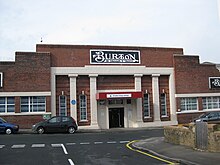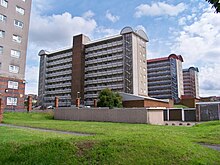
Rothwell is a town in the south-east of the City of Leeds metropolitan borough in West Yorkshire, England. It is situated between Leeds and Wakefield.
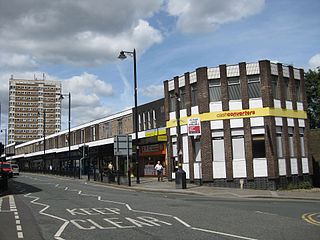
Armley is a district in the west of Leeds, West Yorkshire, England. It starts less than 1 mile (1.6 km) from Leeds city centre. Like much of Leeds, Armley grew in the Industrial Revolution and had several mills, one of which now houses the Leeds Industrial Museum at Armley Mills. Armley is predominantly and historically a largely working class area of the city, still retains many smaller industrial businesses, and has many rows of back-to-back terraced houses.
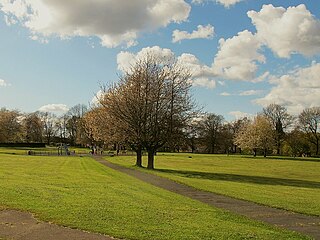
Wortley is an inner city area of Leeds, West Yorkshire, England. It begins one mile to the west of the city centre. The appropriate City of Leeds ward is called Farnley and Wortley.
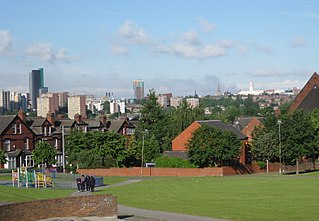
Harehills is an inner-city area of east Leeds, West Yorkshire, England. It is approximately 1 mile (1.6 km) north east of Leeds city centre. Harehills is situated between the A58 and the A64. It sits in the Gipton & Harehills ward of Leeds City Council and the Leeds East parliamentary constituency, between Burmantofts and Gipton, and adjacent to Chapeltown.

Chapeltown is a suburb of north-east Leeds, in West Yorkshire, England. It is part of the Leeds City Council Ward of Chapel Allerton. It is approximately one mile north of Leeds city centre.

Hunslet is an inner-city area in south Leeds, West Yorkshire, England. It is 1 mile (1.6 km) southeast of the city centre and has an industrial past.

Bramley is a district in west Leeds, West Yorkshire, England. It is part of the City of Leeds Ward of Bramley and Stanningley with a population of 21,334 at the 2011 Census. The area is an old industrial area with much 19th century architecture and 20th century council housing in the east and private suburban housing in the west.

Gipton is a suburb of east Leeds, West Yorkshire, England, between the A58 to the north and the A64 to the south.

Eccleshill is an area, former village, and ward within the City of Bradford Metropolitan District Council in the county of West Yorkshire, England. The ward population of Eccleshill is 17,540, increasing at the 2011 Census to 17,945. Eccleshill is a more or less completely residential urban area with very little open space although there is substantial open land directly to the east.

Richmond Hill is a district of Leeds, West Yorkshire, England. The district lies a mile to the east of the city centre between York Road, East End Park and Cross Green. The appropriate City of Leeds ward is Burmantofts and Richmond Hill.
There are over 3,300 listed buildings in City of Leeds district. Lists of buildings in the upper two categories can be found at Grade I listed buildings in West Yorkshire and Grade II* listed buildings in Leeds.

Potternewton is a suburb and parish between Chapeltown and Chapel Allerton in north-east Leeds, West Yorkshire, England. It is in the Chapel Allerton ward of Leeds City Council.

Cross Green is a mainly industrial area of Leeds, West Yorkshire, England. It is around 1 mile (1.6 km) on a hill to the south east of Leeds city centre, with the A63 road running through the middle and dividing it into a residential estate with playing fields and housing to the north, and a large industrial estate to the south. The area lies in the LS9 Leeds postcode area between Osmondthorpe, Richmond Hill and Hunslet.

The architecture of Leeds, a city and metropolitan borough in West Yorkshire, England, encompasses a wide range of architectural styles and notable buildings. As with most northern industrial centres, much of Leeds' prominent architecture is of the Victorian era. However, the City of Leeds also contains buildings from as early as the Middle Ages such as Kirkstall Abbey, one of Britain's best preserved ruined Cistercian monasteries, as well as examples of 20th century industrial architecture, particularly in the districts of Hunslet and Holbeck.

Ever since its early days Hunslet has been the 'Workshop of Leeds'. Although from the Industrial Revolution onwards there have been other areas in Leeds to have a large industrial base, such as Holbeck, Armley, Kirkstall and Harehills, none so much as Hunslet. Like neighbouring Holbeck, Hunslet benefited from its close proximity with the River Aire, Leeds city centre, coal mining communities to the south, extensive railways and some of Leeds' best infrastructure. From the 1960s onwards the motorways would also drive industry and commerce in Hunslet.

Chapel Allerton is an inner suburb of north-east Leeds, West Yorkshire, England, 2 miles (3.2 km) from the city centre.
Burmantofts and Richmond Hill is a ward in the metropolitan borough of the City of Leeds, West Yorkshire, England. It contains 15 listed buildings that are recorded in the National Heritage List for England. Of these, one is listed at Grade I, the highest of the three grades, one is at Grade II*, the middle grade, and the others are at Grade II, the lowest grade. The ward includes the areas of Burmantofts, Cross Green, and Richmond Hill. The listed buildings consist of five churches and associated structures, a former school and an active school, a former mill, a former library and public baths, and two monuments in Beckett Street Cemetery.



